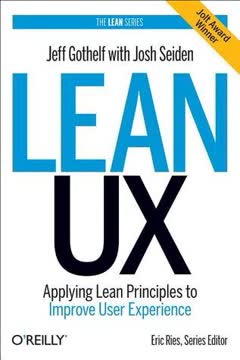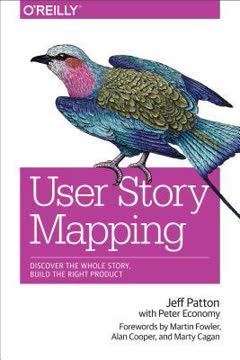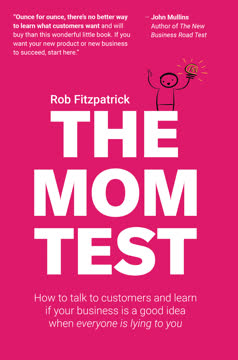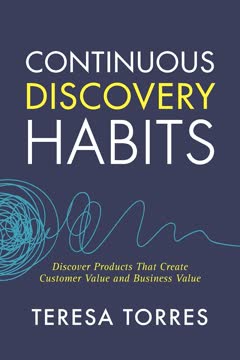重点摘要
1. 持续发现:打造客户想要的产品的关键
至少每周与客户接触一次,由产品团队进行小规模的研究活动,以追求预期的结果。
持续发现是一种结构化的产品开发方法,涉及持续的客户研究和实验。它帮助团队通过以下方式持续提供价值:
- 每周与客户互动,了解他们不断变化的需求
- 进行小而频繁的研究活动,而不是大而不频繁的研究
- 追求明确的预期结果,而不仅仅是发布功能
- 让整个产品团队(产品经理、设计师、工程师)参与客户研究
这种方法使团队能够紧密贴合客户需求,快速适应新信息,并做出基于证据的产品决策。通过将发现变成一种持续的习惯而不是一次性的阶段,团队可以更可靠地创造出客户真正想要和使用的产品。
2. 关注结果而非输出,以驱动真正的价值
你永远不会因为一个功能而成功……你也永远不会。
将思维从输出转向结果。 这意味着:
- 通过为客户和业务创造的价值来定义成功,而不仅仅是发布功能
- 设定明确、可衡量的结果(例如,提高客户保留率10%)
- 允许团队自主决定如何实现结果
- 定期评估产品变更是否推动了预期结果
结果导向的好处:
- 使团队的努力与业务目标保持一致
- 鼓励在解决问题方面的创新
- 当初始解决方案不起作用时允许调整方向
- 衡量真正的影响,而不仅仅是活动
通过关注结果,团队避免了“构建陷阱”,即无休止地发布功能而不创造真正的价值。他们通过看到工作对客户和业务的实际影响而保持动力。
3. 映射和优先考虑客户机会
结构是复杂的。它完成、撤销并重新完成。
创建机会解决方案树。 这个可视化工具帮助团队:
- 映射出客户的需求、痛点和愿望(机会)
- 从广泛到具体地分层结构化机会
- 优先考虑首先要解决的机会
- 生成和评估潜在的解决方案
构建和使用树的步骤:
- 从顶部的预期结果开始
- 分支到高层次的机会领域
- 将每个领域分解为更具体的机会
- 根据以下标准评估机会:
- 对客户的重要性
- 对结果的潜在影响
- 解决的可行性
- 选择一个目标机会进行关注
- 为该机会生成多个解决方案想法
这棵树提供了对问题空间的共同理解,并帮助团队在决定将精力集中在哪里时做出战略决策。它是一个随着团队对客户和市场的了解而不断发展的活文档。
4. 定期进行客户访谈以发现真实需求
人们不知道他们想要什么,直到你展示给他们看。
通过访谈发现机会,而不是验证解决方案。 关键原则:
- 每周进行访谈以保持持续的学习循环
- 专注于收集具体的故事,而不是一般的意见
- 询问最近的经历,而不是假设的未来行为
- 倾听潜在需求,而不仅仅是功能请求
访谈结构:
- 确定范围:定义要探索的客户体验部分
- 询问具体的故事:“告诉我你上次……的经历”
- 深入挖掘:使用后续问题了解背景和动机
- 捕捉机会:记录表达的需求、痛点和愿望
- 综合:创建访谈快照,总结关键见解
定期访谈帮助团队保持与客户现实的联系,捕捉新兴趋势,并建立同理心。它提供了一个不断的机会流,以告知产品决策。
5. 生成和测试多个解决方案想法
创意团队知道,数量是质量的最佳预测指标。
广泛构思,然后聚焦。 方法:
- 个人生成许多想法(每人目标15-20个)
- 团队分享想法并在彼此的概念上进行构建
- 选择一组多样化的3个有前途的解决方案进行进一步探索
多个解决方案的好处:
- 增加找到创新方法的机会
- 减少对单一想法的固执
- 允许比较和对比选项
测试过程:
- 为每个解决方案创建简单的原型或模型
- 定义明确的评估标准(例如,“10个用户中有7个可以完成任务”)
- 与少量客户(5-10个)进行测试
- 比较各解决方案的结果
- 根据学习结果进行迭代或调整
通过并行探索多个解决方案,团队可以更快地识别出成功的想法,避免过度投入于次优方案。
6. 早期识别和测试关键假设
好的测试会杀死错误的理论;我们仍然活着,可以再次猜测。
浮现并测试风险假设。 步骤:
- 列出每个解决方案想法的假设(可取性、可行性、可行性)
- 根据重要性和不确定性映射假设
- 识别“信仰飞跃”假设(高重要性,高不确定性)
- 设计小实验来测试这些关键假设
- 在运行测试之前设定明确的成功标准
假设测试类型:
- 烟雾测试:在构建之前评估兴趣(例如,登录页面注册)
- 奥兹巫师:手动模拟功能
- 礼宾服务:为早期采用者提供高接触服务
- 假门:测量对不存在功能的点击
早期测试假设帮助团队:
- 快速验证或否定想法
- 减少构建错误事物的风险
- 更快地学习和迭代
- 做出基于数据的决策
通过系统地识别和测试假设,团队可以在大量投资开发之前增加对解决方案想法的信心。
7. 在发现和交付过程中衡量影响
你的错觉,无论多么令人信服,都会在数据的严酷光照下枯萎。
为产品设置衡量结果的工具。 关键步骤:
- 定义与预期结果相关的明确指标
- 实施分析以跟踪这些指标
- 在进行更改之前建立基线
- 衡量每次产品迭代的影响
- 寻找长期结果的领先指标
考虑的指标类型:
- 产品指标:直接衡量产品使用和行为
- 业务指标:衡量对公司目标的影响(收入、保留)
- 客户指标:衡量客户满意度和成功
最佳实践:
- 从小处着手:不要试图一次测量所有内容
- 专注于可操作的指标,以告知决策
- 寻找产品变更与结果指标之间的相关性
- 耐心等待:有些影响需要时间才能显现
持续测量使团队能够:
- 验证解决方案是否推动了预期结果
- 识别改进的领域
- 做出基于数据的优先级决策
- 向利益相关者展示他们工作的价值
8. 管理发现周期并根据需要进行调整
信任过程可以给你信心去冒险。
接受发现的混乱现实。 关键原则:
- 预期意外并准备好调整
- 将大机会分解为更小的、可测试的部分
- 平衡短期胜利与长期战略赌注
- 认识到何时坚持,何时改变方向
常见的发现情景:
- 了解到一个机会并不像最初想象的那样重要
- 发现一个解决方案比预期的更复杂
- 发现新的约束或要求
- 发现意外的客户行为或偏好
面对意外时:
- 重新评估假设和假说
- 如果需要,返回发现过程的早期步骤
- 向利益相关者传达变更和理由
- 寻找实现预期结果的替代路径
通过保持灵活性并对新信息做出响应,团队可以驾驭产品开发的固有不确定性,并找到创造价值的最佳路径。
9. 通过展示工作与利益相关者合作
领导者越能理解团队的进展,他们就越会退后一步,让团队执行。
通过透明度建立信任。 策略:
- 使用可视化工件(机会树、故事地图)分享思路
- 从预期结果开始,而不仅仅是解决方案
- 向利益相关者展示你的发现过程和关键决策
- 在适当的时刻邀请输入和共同创造
利益相关者合作的好处:
- 利用多样化的观点和专业知识
- 为产品决策建立认同感
- 减少对新想法的抵制
- 使产品工作与更广泛的业务目标保持一致
有效的利益相关者管理技巧:
- 根据每个利益相关者的需求和兴趣调整细节水平
- 定期、简短的更新通常比不频繁的长时间演示更好
- 对反馈持开放态度,但使用数据和客户见解支持决策
- 庆祝成功和有价值的失败
通过积极让利益相关者参与发现过程,团队可以创建对产品战略的共同理解,并增加组织对其工作的支持。
最后更新日期:
FAQ
What's "Continuous Discovery Habits" about?
- Focus on Discovery: "Continuous Discovery Habits" by Teresa Torres is about adopting a structured and sustainable approach to product discovery that continuously involves customer input.
- Framework and Habits: The book introduces a framework and a set of habits that help product teams discover opportunities and solutions that create customer and business value.
- Outcome Over Output: It emphasizes focusing on outcomes rather than outputs, ensuring that product decisions are driven by customer needs and business goals.
- Iterative Process: The book advocates for an iterative process where discovery and delivery are interwoven, allowing teams to adapt and learn continuously.
Why should I read "Continuous Discovery Habits"?
- Practical Guidance: The book provides practical guidance on how to implement continuous discovery in your product development process.
- Improved Decision-Making: It helps improve decision-making by teaching how to balance customer needs with business outcomes.
- Real-World Examples: The book includes real-world examples and case studies that illustrate the application of continuous discovery habits.
- Empowerment: It empowers product teams to take ownership of their discovery process, leading to better products and increased confidence in their work.
What are the key takeaways of "Continuous Discovery Habits"?
- Continuous Customer Engagement: Regularly engage with customers to discover and validate opportunities and solutions.
- Outcome-Oriented Mindset: Shift from focusing on outputs to achieving desired outcomes that benefit both customers and the business.
- Structured Discovery Process: Use tools like opportunity solution trees to map and prioritize opportunities and solutions.
- Iterative Learning: Embrace an iterative approach to learning and adapting, ensuring that discovery and delivery inform each other.
What is the "Opportunity Solution Tree" in "Continuous Discovery Habits"?
- Visual Framework: The opportunity solution tree is a visual framework that helps teams map out paths to achieve desired outcomes.
- Structure and Prioritize: It structures the opportunity space, allowing teams to prioritize opportunities and solutions effectively.
- Resolve Tensions: The tree helps resolve tensions between business needs and customer needs by aligning them through opportunities.
- Shared Understanding: It builds a shared understanding across the team, facilitating better collaboration and decision-making.
How does "Continuous Discovery Habits" define continuous discovery?
- Weekly Touchpoints: Continuous discovery involves at least weekly touchpoints with customers by the team building the product.
- Small Research Activities: These touchpoints include small research activities aimed at understanding customer needs and validating assumptions.
- Desired Outcome Focus: The process is in pursuit of a desired outcome, ensuring that discovery efforts are aligned with business goals.
- Iterative and Sustainable: The approach is iterative and sustainable, allowing teams to adapt and learn continuously.
What are the "Continuous Discovery Habits" mentioned in the book?
- Outcome Over Output: Focus on achieving outcomes rather than delivering outputs.
- Visualize Knowledge: Use tools like experience maps and opportunity solution trees to visualize and structure knowledge.
- Continuous Interviewing: Regularly interview customers to discover and validate opportunities.
- Assumption Testing: Identify and test assumptions quickly to iterate on solutions effectively.
How does "Continuous Discovery Habits" suggest prioritizing opportunities?
- Opportunity Sizing: Assess opportunities based on how many customers are affected and how often.
- Market and Company Factors: Consider market trends, competitive positioning, and company strengths and weaknesses.
- Customer Importance: Evaluate how important each opportunity is to customers and their satisfaction with current solutions.
- Iterative Assessment: Use the opportunity solution tree to iteratively assess and prioritize opportunities.
What is the role of "Assumption Testing" in "Continuous Discovery Habits"?
- Identify Assumptions: Identify hidden assumptions behind solution ideas to uncover potential risks.
- Test Quickly: Test assumptions quickly to gather evidence and reduce risk before investing heavily in solutions.
- Iterative Learning: Use assumption testing to iterate on solutions, learning from both successes and failures.
- Compare and Contrast: Test assumptions across multiple ideas to compare and contrast their potential effectiveness.
How does "Continuous Discovery Habits" recommend measuring impact?
- Instrument Prototypes: Instrument live prototypes to evaluate assumption tests and measure impact on desired outcomes.
- Outcome Alignment: Ensure that product changes are aligned with desired outcomes and measure their impact accordingly.
- Iterative Measurement: Continuously measure and iterate on product changes to ensure they drive the intended outcomes.
- Connect Outcomes: Strengthen the connection between product outcomes and business outcomes to ensure long-term success.
What are the best quotes from "Continuous Discovery Habits" and what do they mean?
- "You are never one feature away from success...and you never will be." This quote emphasizes that success is not about delivering a single feature but about continuously addressing customer needs and business goals.
- "Trusting the process can give you the confidence to take risks." It highlights the importance of having a structured discovery process that allows teams to take calculated risks and learn from them.
- "Good tests kill flawed theories; we remain alive to guess again." This quote underscores the value of assumption testing in identifying and discarding flawed ideas, allowing teams to iterate and improve.
How can I start implementing "Continuous Discovery Habits" in my team?
- Start Small: Begin with small, manageable changes and iterate from there, focusing on what is within your control.
- Build a Trio: Form a cross-functional trio of a product manager, designer, and engineer to collaborate on discovery decisions.
- Continuous Interviewing: Develop a habit of continuous interviewing to keep customer needs at the forefront of your process.
- Reflect and Improve: Use retrospectives to reflect on your discovery process and identify areas for improvement.
What challenges might I face when adopting "Continuous Discovery Habits"?
- Organizational Resistance: You may encounter resistance from stakeholders who are accustomed to traditional ways of working.
- Resource Constraints: Limited resources or lack of access to customers can make continuous discovery challenging.
- Balancing Priorities: Balancing discovery with delivery and other responsibilities can be difficult.
- Iterative Learning: Embracing an iterative learning mindset and being open to change can be challenging but is essential for success.
评论
《持续发现习惯》受到读者的高度赞誉,平均评分为4.48/5。评论者称赞其在产品发现方面的实用方法,提供了可操作的框架和技术。许多人认为这是产品经理、设计师和研究人员必读的书籍。该书因其清晰的表达、真实的案例以及对建立发现习惯的关注而备受推崇。一些读者指出其适用于各种角色和行业。尽管有少数批评提到重复和理想化,但总体而言,这本书因其宝贵的见解和可操作的建议而被高度推荐。
Similar Books














